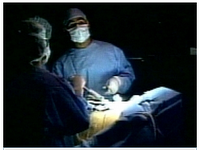What to do when gastric bypass surgery obesity fails

Los Angeles, CA
The number of people getting obesity surgery has more than doubled in the past eight years. But the highly popular and risky procedure doesn't always work for everyone. So can these patients be helped? One local doctor offers a high-tech solution.
When 47-year-old Patricia Weiss gets on a scale these days, she smiles.
"I've lost about 35 pounds since I had it. It's been a year almost a year," said Patricia.
It's been a year since her second time around with an obesity procedure. The first time was in 2002 -- Patricia underwent a gastric bypass and lost 150 pounds. But then the weight started to creep back on.
Story continues below
Advertisement
"I put on about 30 to 40 pounds, and I said, 'No, no, going the wrong way.' I didn't do all this to have this come back," said Patricia.
In 2007, there were about 160,000 to 200,000 gastric bypasses performed -- that's at least double the number performed in 2000. Of those surgeries, doctors say about 15 percent fail.
Often patients regain because they start to over eat again and stretch out their reconstructed pouch. Patricia went to see Dr. Jeremy Korman. He says standard x-rays and endoscopes don't give doctors the whole picture and this makes it difficult to proceed. He says he may be the only surgeon in the U.S. to use the 64 slice CT scan technology on obesity surgery patients.
"Now once we understand accurately the size of the pouch, we can plan what kind of operation would be appropriate, what size of revision operation is appropriate," said Dr. Korman.
Dr. Korman says he can either redo the original surgery, implant a LAP-BAND to restrict the pouch growth, or perform a new minimally invasive endoscopic procedure in which he sews up and shrinks the pouch from the inside.
Patricia opted for the LAP-BAND. More >>
Labels: gastric bypass revision, gastric bypass risks, patient stories

0 Comments:
Post a Comment
<< Home